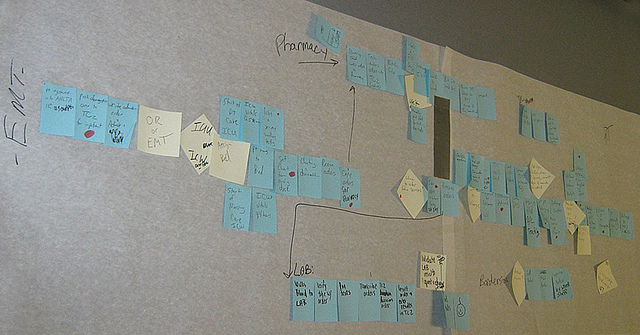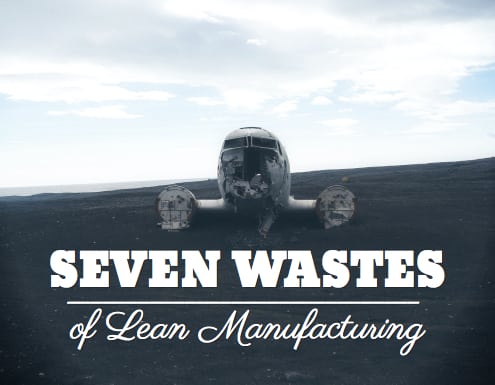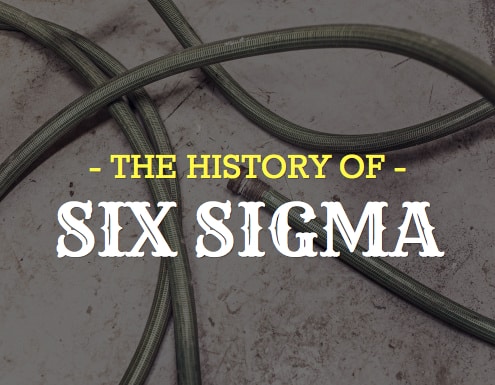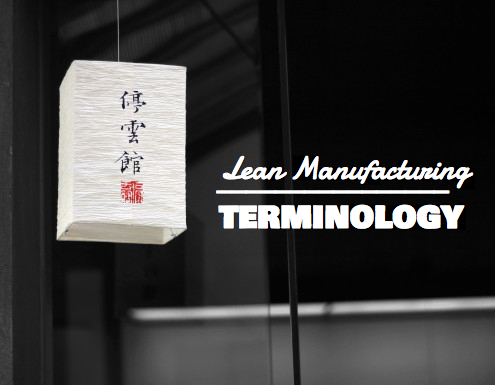
- What is waste?
- The 7 wastes of lean manufacturing
- How to remember the 7 wastes
- The 8 wastes of lean manufacturing
- 7 wastes of lean in services
- 7 wastes of lean in healthcare
What Is Waste?
There are 7 wastes of lean manufacturing that are commonly referenced. Before considering these 7 types of waste though, it is important to consider what is meant by the term waste. Waste can be defined as any activity that consumes resources but creates no value for the customer. It is an activity that the customer is not willing to pay for. Within most business processes, the activities that actually create value as perceived by the customer make up a small percentage of the total activities. Reducing the number of these wasteful activities represents a significant opportunity for businesses to improve their performance. Elimination of the 7 wastes of lean can reduce costs, increase profits, improve employee engagement, reduce rework and improve delivery time. The lean process of plan, do check and act is a fundamental part of identifying and then eliminating waste or muda.
Muda. It’s the one word of Japanese you really must know. It sounds awful as it rolls off your tongue and it should, because muda means “waste,” specifically any human activity which absorbs resources but creates no value: mistakes which require rectification, production of items no one wants so that inventories and remaindered goods pile up, processing steps which aren’t actually needed, movement of employees and transport of goods from one place to another without any purpose, groups of people in a downstream activity standing around waiting because an upstream activity has not delivered on time, and goods and services which don’t meet the needs of the customer.
Lean Thinking~ James P. Womack & Daniel T. Jones
The 7 Wastes of Lean Manufacturing
Waiting
Waiting is perhaps the most obvious of the 7 wastes of lean manufacturing. It is easily identifiable as lost time due to poor flow: parts shortages, bottlenecks, and equipment breakdowns. In an office based environment, this may take the form of slow software loading times or waiting for an important phone call. This is also frustrating for the employees involved, which can lead to reduced morale.
Over Production
Over production is the most important of the 7 types of waste. It is building more of a product than the customer ordered or wanted. Remembering that waste is anything for which the customer is not willing to pay, it is easy to see why over production is a waste. However over production actually drives all of the other six types of waste as well. The excess product now has to be stored somewhere which means excess motion, transportation and inventory. Also, over production means that if a reject is found, there will be more units that need to be reworked.
Rejects
Parts that do not comply with the specifications of the customer lead to rework. Worse still they can lead to scrap and the necessary production of new parts. Usually, rejects have to be sent back down the production line again to be put right. This consumes valuable production time. Sometimes a separate rework area is required, which increases labour and duplicates tooling.
Excess Motion
This is wasted movement that is made while working. It could take the form of having to walk to another area to collect a tool, part or document. It also covers searching for things in a messy environment. A classic example is sorting through piles of paperwork to find the one form required at that moment to complete the job.
Over Processing
This is work that adds no value for the customer or business. This usually takes the form of over engineering a product: unnecessary features that the customer does not use, but that increase the cost to the business. This could be maintaining paint finish or other tolerances, more tightly than is required by the customer. Another example is building a product that will last for five years when the customer is going to replace it after two.
Excess Inventory
Excess material, work in process or finished goods. Excess inventory represents cash tied up in the form of material, which is difficult to turn into cash quickly. Inventory also takes up space. It has to be managed, stored and can become obsolete leading to scrap. The quality of inventory can deteriorate over a period of time, especially perishable items such as food or rubber seals.
Transportation
Unlike excess motion which is wasted movement of people, transportation is excess motion of work in process. This can be at the process level or the value stream level. At the process level, excess transportation can be having machines too far apart so that parts need to be moved on a fork lift truck. At the value stream level, excess transport can be moving finished parts or components between facilities and not consolidating the transport.
How to remember the 7 Wastes of Lean Manufacturing
There is a simple way to remember the 7 wastes of lean manufacturing: simply remember the rather silly acronym WORMPIT!
- Waiting
- Over production
- Rejects
- Motion (Excess)
- Processing (Over)
- Inventory
- Transportation
If you can remember WORMPIT, you can easily use each letter to recall the 7 wastes of lean manufacturing.
Others use a different acronym to remember the 7 wastes of lean TIMWOOD. In this case the term rejects is replaced with defects:
- Transportation
- Inventory
- Motion (Excess)
- Waiting
- Over production
- Over processing
- Defects
However you choose to remember them, the important factor in lean manufacturing is to identify and eliminate the wastes.
For more information see this resource: 7 wastes of lean manufacturing pdf
The 8 Wastes of Lean
Now if you spend enough time around lean manufacturing you will eventually come across an 8th waste. Some companies stick with the original seven, while others have added the waste of unused creativity. This refers to the situation where people and their ideas go unused. Ignoring or not implementing improvement ideas from employees is considered by some to be the worst kind of waste. Eventually it leads to poor engagement and the employees affected will stop contributing. Once this happens it is virtually impossible to regain their commitment.
The 7 Wastes of Lean in Services
As you are probably aware, lean manufacturing principles have been applied increasingly to processes outside the realm of manufacturing. Initially, those companies who saw results on the production shop floor started to apply them in their service and transactional processes. This was an effort to ensure the paperwork such as customer sales orders and supplier purchase orders did not become the constraint. It was just as important for the documents to be error free too.
This focus on office based processes necessitated a rethink about the 7 wastes. How do they show up in a service environment?
Waiting
We’re all familiar with the ominous loading screens and egg timers on our computers as we wait for the processor to catch up. However, there are other examples such as waiting for approval from management, waiting for signatures, waiting for post, waiting for email etc.
Over Production
Typically this is shows up at the printer. It can be paperwork that is printed in batches ahead of when it is required. Any change in an order or process can mean that paperwork becomes obsolete and needs to be reprinted.
Rejects
As we just discussed, paperwork that needs to be reprinted is a great example of the waste of rejects. Data entry errors or typos also fall into this category and can be hard to detect. Obviously they can affect all sorts of process: sales orders, purchase orders, invoices, production work orders, standard work instructions and many more. I’ve even known dimensional errors on drawings lead to a part being manufactured in millimetres instead of inches! It would be funny if it wasn’t true!
Excess Motion
This is usually apparent when offices are arranged by department. This leads to a silo mentality and office staff have to move to speak to colleagues. Other examples are walking to and from the printer, photocopier, stationery stores or filing cabinets. Remember the principles of cellular manufacturing could equally apply to an office process!
Over Processing
Having to enter data more than once is the obvious example in this category. This is often due to not having sufficient access to the same system or drives as a colleague in another department. It can lead to multiple copies of files being generated as they get shared by email. This in turn leads to synchronisation problems and different numbers depending on which spreadsheet you look at or who you ask. Many of the reports generated on a daily basis and circulated probably fall into the over processing category too.
Inventory
In many ways, this is easier to see in a service environment. You only need to look at the inboxes and paper trays stacked high on everybody’s desks. Inboxes can be virtual too - how many people have an empty email inbox? Then there are the hoards of stationery!
Transportation
This is less obvious perhaps, but it still exists in an office. Remember that transportation refers to the movement of work in process. If the route is not as direct as it could be then there is waste. So to apply that think about processes that have multiple review points or hand-offs. Or how about multiple people copied on an email instead of the one who actually needs to do something?
As you can see, it really doesn’t take much adjustment to apply lean thinking to a service or transactional based environment. The best way to spot these wastes in service processes is the same too…walk the process and ask questions. See where the bottlenecks are and ask why. You know the rest!
The 7 Wastes of Lean in Healthcare
Similar to the previous section, with a little thought it is also possible to see how the 7 wastes apply to healthcare processes too. The thing to remember here is the value stream. In healthcare we are trying to remove waste to allow value (the patient) to flow from one door of the factory (hospital) as quickly and efficiently as possible. In other words we are trying to speed up their diagnosis, treatment and recovery.
Waiting
Waiting rooms. Seriously. Do I really need to write any more on this one? There are other examples though such as waiting for lab results or waiting for discharge.
Over Production
This is probably more difficult to translate to healthcare. Remember over production is making more of something or making it sooner than the customer demands it. So producing too much medication in the pharmacy, or too many meals in the kitchen. Alternatively producing them too soon, only to find the doctor changed the prescription or the patient changed their meal choice which leads to rework.
Rejects
As much as we don’t like to think about it, what we’re really talking about here is mistakes in healthcare. So things like misdiagnoses, incorrect medication, surgical errors all fall into this category. All the more reason to use the lean principles to standardise and poka yoke the process.
Excess Motion
This really covers medical staff having to move more than necessary between various parts of the hospital to do their job, including gathering information and medical supplies or equipment.
Over Processing
This is easier to understand in a healthcare environment. It shows up when a patient undergoes unnecessary or surplus tests or treatments “just in case”. This increases their length of stay and the cost of their treatment.
Inventory
In the case of healthcare, inventory can refer to medical supplies and equipment which can be overstocked. This can lead to obsolescence or expiry in the case of drugs. However, inventory can also refer to patients. If there are more patients than the system can handle they will gather at bottleneck processes, which leads to extended waiting times and stress all around. More patients in the hospital for longer than necessary leads to beds not being available when required and increased risk of catching an infection and other such problems.
Transportation
Movement of patients between wards and various departments for tests or treatment. Older hospitals were built with similar departments located close together (batch manufacturing anyone?). It would be less wasteful to have all of the required processes, tests and equipment in one place to minimise the transportation of the patient. Obviously this can be a problem logistically if there are large items of capital expenditure required such as MRI scanners. It would be difficult to have one on every ward.
For further thoughts on waste in healthcare check out this resource: 7 wastes of lean pdf









